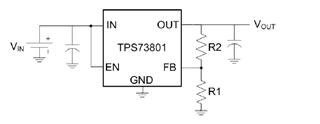Tool/software:
Hello
In one of our boards we are using TPS73801DCQR LDO for the 5V->3.3V regulation.
In the datasheet it is mention " The value of R1 should be less than 4.17 kΩ to minimize errors in the output voltage caused by the FB pin bias current. "


But in our design we have: R1=10K and R2=17.4K.
I can't understand from Vout calculation formula why R1 should be below 4.17K ?
1. What kind of problems we can encounter because we have R1=10K in our design? Please elaborate affect of this R1 on this bias issue (by my logic I thought that the greater value of R1 should be better ??).
2. Also is this TPS73801DCQR recommended for the new design (where we will initially will set R1 and R2 to the recommended values) ?
Thank you.
Alex

